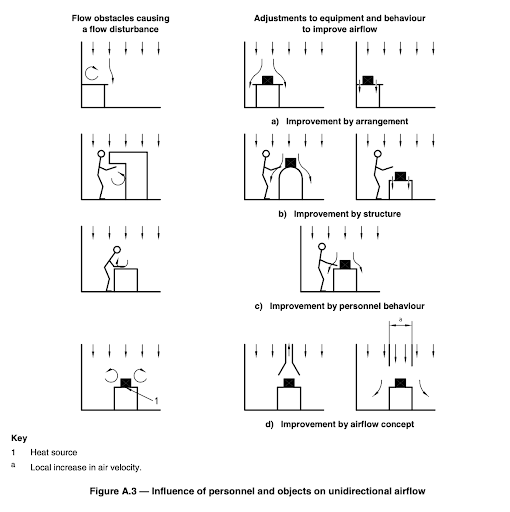Cleanrooms are designed to maintain strict control over environmental factors, but they’re only effective if they have an expertly designed airflow pattern to help them reach the desired cleanliness level and ISO classification standard. ISO document 14644-4 describes airflow patterns to be used in cleanrooms at the different classification levels in order to maintain strict airborne particle counts and cleanliness.
Cleanroom airflow must allow the air within the cleanroom to be completely changed to remove particles and potential contaminants before they can settle. In order to do this properly, the airflow pattern must be uniform — ensuring every part of the space can be reached with clean, filtered air.
To break down the importance of cleanroom airflow uniformity, we need to start by looking at the three main types of airflow in cleanrooms.
3 Types of Cleanroom Airflow Patterns
Cleanroom airflow can be unidirectional, non-unidirectional, or mixed — a combination of both. The best cleanroom airflow type will depend on the cleanroom classification. Generally, cleanrooms of an ISO Class 6 or greater can use a mixed or non-unidirectional airflow pattern, while ISO Class 5 (or cleaner) cleanrooms rely on unidirectional airflow.
#1 Unidirectional Cleanroom Airflow
This type of cleanroom air moves in one direction across the room, either horizontally or vertically from fan filter units to the exhaust system that removes “dirty” air. Unidirectional flow requires as little disturbance as possible to maintain a uniform pattern.
#2 Non-Unidirectional Cleanroom Airflow
In a non-unidirectional airflow pattern, air enters the cleanroom from filter units located in multiple locations, either spaced throughout the room or grouped together. There are still planned entrance and exit points for air to flow along more than one path.
Although air quality is less critical compared to unidirectional airflow cleanrooms, special attention should be paid to make sure air is changed thoroughly, minimizing the potential for “dead zones” within the cleanroom.
| Dead zones are areas where air is turbulent or not being changed and may result in deposited particles or a buildup of contaminants. |
#3 Mixed Cleanroom Airflow
Mixed airflow combines both unidirectional and non-unidirectional airflow. Unidirectional airflow may be used in specific areas to boost protection around working areas or more sensitive materials, while non-unidirectional airflow still circulates clean, filtered air throughout the rest of the room.
Why Cleanroom Airflow Uniformity Matters
Whether a cleanroom airflow is unidirectional, non-unidirectional, or mixed, having a uniform cleanroom airflow pattern matters. Cleanrooms are meant to be controlled environments where all systems should work to prevent areas where buildup of contaminants can occur — via dead zones or turbulence.
What is Turbulent Air?
Turbulent air, or chaotic air, in a cleanroom is a serious threat to cleanliness. Turbulent air occurs when the airflow pattern is not uniform.
Think of a current moving through water. If the flow was uniform, all of the water would move steadily at the same speed. Obstructions or varying speeds, like rocks or rapids, impede the uniformity of the flowing water. Similarly, when you sweep your hand through water and see eddies and whirlpools form to the side of the current, that’s turbulence.
Eddies in water may be harmless, but turbulence in cleanroom airflow can cause the uncontrolled movement of contaminating particles — or dead zones where no air is moving at all, where contaminants can build up and threaten sensitive processes in the cleanroom.
What Causes Turbulent Air in Cleanrooms?
Turbulence in cleanroom airflow can be caused by non-uniform speeds of air entering the room or obstructions in the path of incoming or outgoing air. Airflow uniformity is about preventing unnecessary turbulent air so the cleanroom can perform at peak efficiency.
Minimizing Turbulence in Cleanrooms
You can minimize turbulence by designing the cleanroom airflow pattern to work with your layout, equipment, furniture, and personnel. The cleanroom should be removing air at the same or similar speed as it enters. This gives air a clear path to flow to prevent turbulence and dead zones.
Obstructions can also cause turbulent air, so make sure that no large furniture or equipment is blocking fan filter units or exhaust. Adjust equipment with aerodynamic attachments or design features to facilitate airflow, use perforated cleanroom tables to allow air to pass through uninhibited, or modify behavior of personnel to not block or impede airflow within critical zones.
Cleanroom Airflow and Pressurization
Another way to minimize contamination using a uniform airflow pattern to establish positive or negative air pressure. Cleanroom pressurization creates a natural barrier to protect or isolate cleaner or less clean zones, respectively. Using negative and positive pressure can be especially useful for sensitive applications such as the manufacturing of healthcare products, medical research, microelectronics, and more.
Custom Cleanroom Airflow Design
Cleanroom airflow patterns should be designed to work with each unique cleanroom layout and all the furniture, systems, and personnel in the cleanroom for optimal cleanliness during operation.
A cleanroom engineer uses computational fluid dynamics to map out the cleanroom and place fan filter units and outlets appropriately to meet your classification requirements. This system allows the designer to visualize the pattern of air and make adjustments for cleanroom systems, equipment, and personnel in order to achieve uniformity. It also allows you to anticipate your energy requirements and make your facility as efficient as possible.
As your ISO cleanroom classification gets lower, having an expertly designed airflow pattern becomes more and more crucial. Work with an expert to make sure your cleanroom airflow is as uniform as possible for your application.
Trust the Angstrom Technology Cleanroom Airflow Design Experts
Designing your cleanroom and need a little help establishing an efficient, uniform airflow pattern? Call the experts at Angstrom Technology. From cleanroom airflow design to HVAC and filtration maintenance, we can help you make the best choices for your budget and your classification.





